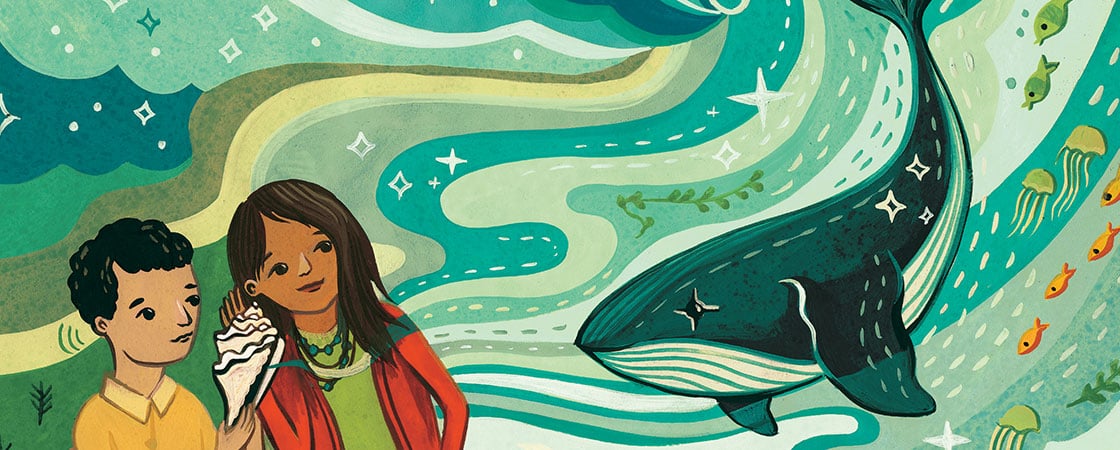We travel carrying our words.
We arrive at the ocean.
With our words we are able to speak
of the sounds of thunderous waves.
We speak of how majestic it is,
of the ocean power that gifts us songs.
We sing of our respect
and call it our relative.

Learning Objective: Students will explore what the ocean and the speakers in the poem offer each other with the sounds they make.
Carrying Our Words
We travel carrying our words.
We arrive at the ocean.
With our words we are able to speak
of the sounds of thunderous waves.
We speak of how majestic it is,
of the ocean power that gifts us songs.
We sing of our respect
and call it our relative.
used by permission of the poet
Author Ofelia Zepeda reads another one of her poems, “O’odham Dance,” in both English and in Tohono O’odham. The accompanying visuals show beautiful footage of the Sonoran Desert, which is home to the Tohono O’odham Nation. [Fun connection to this issue’s fiction story: The Sonoran Desert is also where the saguaro cactus grows.]
Experience what makes the ocean such an incredible place with five minutes of stunning footage from BBC’s Blue Planet II. Your students will be amazed by all of the amazing animals that call the ocean home. Note: This is a trailer for the TV series. There isn’t a lot of dialogue, but you could choose to show this with the sound off or select a portion in which the series is not mentioned.
Want to know the science behind why you “hear the ocean” when you put a seashell to your ear? This entertaining three-minute video from SciShow Kids offers a clear and simple explanation.
More About the Article
Essential Question
How are humans connected to nature?
Key Skills
interpreting text, text features, vocabulary, point of view, key idea, supporting detail, theme
1. PREPARING TO READ
Set a Purpose for Reading (10 minutes)
Ask: What sounds does the ocean make? Students might wish to try to make the sounds of the ocean or to use words to describe those sounds.
Read aloud the bubble labeled Big Idea. As students read, they should look for the different ways that humans and the rest of nature talk to one another and to think about why the sounds of each are special and important.
Preview Text Features and Vocabulary
Point out the Author Close-Up bubble and explain that the poem was first written in O’odham, a Native American language, by Ofelia Zepeda. She then translated it into English. Zepeda is a member of the Tohono O’odham Nation, a group of Native American people from Arizona and Mexico. [pronunciation of Ofelia Zepeda is available here and pronunciatio nof Tohono O’odham is available here.]
Point out the word thunderous in the fourth line and ask if anyone knows its definition. Help them see that the word thunder is part of thunderous and provides a clue about its meaning.
Ask students to describe what is happening in the illustration. What might the children be doing with the shell? (Some students may not be aware that you can “hear the sound of the ocean” by holding a seashell up to your ear.)
2. READING AND DISCUSSING
Read the poem to the class, play the audio version, or use text-to-speech.
Next, ask students to take turns reading aloud each line in the poem.
Close-Reading and Critical-Thinking Questions (30 minutes)
3. SKILL BUILDING
Featured Skill: Interpreting Text
Distribute our Understanding the Poem Skill Builder (available in your Resources tab) and have students complete it in class or for homework.
After completing the Skill Builder, students can share their pictures in class or online.
GREAT IDEAS FOR REMOTE LEARNING
Have students record video or audio of themselves reciting the poem. Encourage them to include sounds that they feel represent the ocean. Invite students to share their recordings with you, or if they would like, with the class.
Read the poem aloud as students follow along. Pause after lines 1-4 and again after lines 5-8 to discuss what is happening in those lines. Afterward, have students work in pairs to complete the poetry Skill Builder.
Your ELL students might appreciate that the poem was translated from another language. After working with them on understanding the poem, ask them to choose a line to say in their native language.
Instruct students to write a short paragraph with their answers to the essential question from the beginning of the lesson plan: How are humans connected to nature? In their answers, they should include what part (or parts) of nature they feel a special connection with.
Ask students to choose another part of nature that they would like to honor or celebrate. Have them write a thank-you note to that part of nature. Have them include what gifts they give to nature, and what gifts nature gives to them.